- A+
前言
熟悉 Angular 的朋友都知道,Angular 有非常多的局限,许多事情它都做不好,打开 Github 一堆 2016 - 2017 的 Issues,时至今日都没有解决。
原因也很简单 -- Angular 团队的不作为?。
通常我会把常见的 Angular 的局限记入在这篇 <<Angular 的局限和 Github Issues>>,但由于本篇要讲的问题篇幅比较大,所以特别把它分一篇出来。
本篇要讲的是 Angular Query Element 的局限。虽然我们已经在 <<Component 组件 の Query Elements>> 文章中,深入理解了 Angular 的 Query 机制。
但是!理解没有用啊。
如果它本来做的到,但由于我们不理解,所以以为做不到,那去理解它是对的。
但如果它本来就无能,我们即便理解了,也只是知道它为什么做不到,最终任然是做不到啊?。
本篇,我们一起来看看 Angular 在 "Query Elements" 上有哪些局限,有没有什么方法可以去突破它。
不支持 viewChildren descendants
App Template 里有一个 Parent 组件
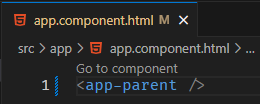
Parent Template 里有一个 Child 组件
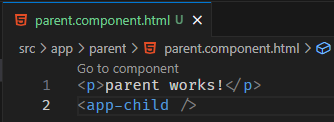
结构

尝试在 App 组件里 query Child 组件

export class AppComponent { child = viewChild(ChildComponent); parent = viewChild(ParentComponent); constructor() { afterNextRender(() => { console.log(this.child()); console.log(this.parent()); }) } }
View Code

不奇怪,因为 Angular 也有 Shadow DOM 概念,组件是封闭的,上层无法直接 query 到 ShadowRoot 内的 elements。
by default 不行,OK!我可以接受,但如果我真的想要 query,你总要给我个方法吧?
Layer by layer query
方法是有,只是...
把 viewChild Child 移到 Parent 组件里
export class ParentComponent { child = viewChild(ChildComponent); }
现在变成 App query Parent query Child ?

如果有很多层,那每一层组件都需要添加这个 viewChild 逻辑...
虽然我们确实做到了,但这种写法在管理上是很有问题的。
假设,有 A 到 Z 组件 (一层一层,共 26 层)。
A 想 query Z。
那在管理上,这件事就不可以影响到除了 A 和 Z 以外的人。
但按照上述的方法,B 到 Y 组件都需要添加 viewChild 逻辑才能让 A query 到 Z,这显然已经影响到了许多不相干的人,管理直接不及格?!
原生的 Web Component ShadowRoot 都没有这么糟糕

虽然也是一层一层往下 query,但至少 B - Y 组件内不需要增加不相干的代码。
Use inject instead of query
Angular query child element 有限制,但很神奇的 query parent 却没有限制。(这和 ShadowRoot 不一样,ShadowRoot query parent 和 child 都限制)
于是我们可以尝试反过来做。
App 组件
export class AppComponent { public child!: ChildComponent; constructor() { afterNextRender(() => { console.log(this.child); }) } }
准备一个空的 child 属性
接着在 Child 组件 inject App,然后填入 Child 实例。
export class ChildComponent { constructor() { const app = inject(AppComponent); app.child = this; } }
这样 App 组件就 "query" 到 Child 了。

间中,Parent 组件完全不需要配合做任何事情。这个方案,管理...过?
上难度 の 动态组件
看似我们好像是突破了 query 的局限,但其实不然...☹️
假设 Child 组件要支持动态插入。
首先,我们需要把 children 改成 signal (这样可以监听变化)
export class AppComponent { public children = signal<ChildComponent[]>([]); constructor() { effect(() => console.log(this.children())); // 监听变化 } }
接着
export class ChildComponent { constructor() { // 初始化时添加 const app = inject(AppComponent); app.children.set([...app.children(), this]); // destroy 时删除 const destroyRef = inject(DestroyRef); destroyRef.onDestroy(() => app.children.set(app.children().filter(c => c === this))) } }
嗯...只是改一改,方案视乎还可以,没有翻车...?
上难度 の maintain sequence
假设,Parent 组件里有 3 个 Child 组件 (代号 A, B, C)
@if (show()) { <app-child /> } <app-child /> <app-child />
第一次 console.log 结果是 B, C,因为 A 被 @if hide 起来了。
接着我们 show = true。
第二次的 console.log 结果是 B, C, A。
注意不是 A, B, C 而是 B, C, A。
因为在 Child 初始化的时候,Child instance 是被 "push" 到 query results 里。
这就导致了 sequence 不一致。
为什么用 push?换成 unshift, splice 可以吗?
可以,但是没有用,因为 Child 不可能知道自己的位置,所以它也无法确定要用 push, unshift 还是 splice。
是的...这个方案翻车了?,这种时候,我们还得用回 layer by layer query 方案...
好,这个问题我们先隔着,继续往下看看其它 Query Elements 的问题。
不支持 viewChildren <ng-container /> 和 <ng-content />
相关 Github Issue:
Github – ContentChildren doesn't get children created with NgTemplateOutlet (2017)
App Template
<ng-template #template> <app-child /> </ng-template> <ng-container #container />
一个 ng-template 和一个 <ng-container />
App 组件

export class AppComponent implements OnInit { readonly templateRef = viewChild.required('template', { read: TemplateRef }); readonly viewContainerRef = viewChild.required('container', { read: ViewContainerRef }); readonly child = viewChild(ChildComponent); constructor() { // 2. 查看是否可以 query 到 Child 组件 afterNextRender(() => console.log(this.child())) } ngOnInit() { // 1. create <ng-template> and insert to <ng-container /> this.viewContainerRef().createEmbeddedView(this.templateRef()); } }
View Code
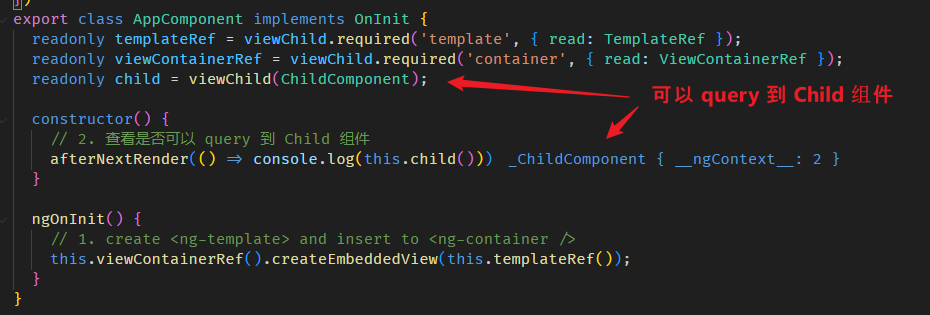
App 组件成功 query 到 Child 组件。
好,我们改一改结构
App Template
<app-parent> <ng-template #template> <app-child /> </ng-template> </app-parent>
把 ng-template transclude 给 Parent 组件
Parent Template
<p>parent works!</p> <ng-container #container />
Parent 组件

export class ParentComponent implements AfterContentInit { readonly templateRef = contentChild.required(TemplateRef); readonly viewContainerRef = viewChild.required('container', { read: ViewContainerRef }); readonly child = viewChild(ChildComponent); constructor() { // 2. 查看是否可以 query 到 Child 组件 afterNextRender(() => console.log('Parent query Child succeeded?', this.child())); // undefined } ngAfterContentInit() { // 1. create <ng-template> and insert to <ng-container /> this.viewContainerRef().createEmbeddedView(this.templateRef()); } }
View Code

Parent 组件无法 query 到 Child 组件。
但是 App 组件任然可以 query 到 Child 组件。

Why?!
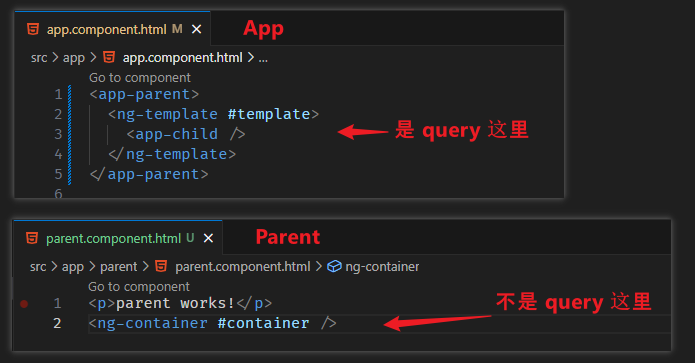
因为 Angular 的 query 机制是 based on declare 的地方,而不是 insert 的方法。
我们可以 query <ng-template>,但是不可以 query <ng-container />。
我们经常有一种错误,觉得 <ng-container /> 可以被 query。
<ng-container *ngIf="true"> <app-child /> </ng-container>
这是因为被 *ngIf,*ngFor 误导了。
上面 *ngIf 只是语法糖,它的正确解读是
<ng-template [ngIf]="true"> <ng-container> <app-child /> </ng-container> </ng-template>
我们之所以能 query 到 Child 是因为,它在 ng-template 里面,
另外上面这段代码里, <ng-container /> 只是一个摆设而已,正真作为 ViewContainerRef 的 element 也是 ng-template (任何一种 element 都可以成为 ViewContainerRef,不一定是 <ng-container />,<ng-template> 也可以的)。
除了 <ng-container /> 不能被 query,<ng-content /> 也不能被 query。
viewChildren ng-template 顺序的问题
相关 Github Issue – QueryList not sorted according to the actual state
我在 <<Angular 高级教程 – 学以致用>> 文章中详细讲解过这个问题了,这里不再复述。
How to solve?
<app-parent> <ng-template #template> <app-child /> </ng-template> </app-parent>
上面这种情况,虽然 Parent 无法 viewChild Child 组件,但是可以 contentChild Child 组件。
另外 Child 也可以 inject 到 Parent,所以也可以像上一 part 那样 use inject instead of query。
但这些方式也都有局限。假如 ng-template 被丢到千里之外的 <ng-container /> 那 contentChild 和 inject 都可能连不上它们,这样就真的无计可施了。
问题小总结
问题:
-
viewChild 不能 descendants
-
query 不到 inside <ng-container /> 和 <ng-content />
- query ng-template 顺序和 ViewContainerRef 不一致
这些问题归根究底都是因为 Angular 的奇葩 query 机制。
Angular query child 查找的是 Logical View Tree,而不是 DOM Tree。
Angular query parent 查找的是 Injector Tree,而不是 DOM Tree。
Angular query 机制对静态友好,对动态不友好 (一旦有动态组件,它要嘛完全 query 不到,要嘛顺序不对...?)
安全范围
怎么能不掉坑呢?
-
viewChild 控制在 1 layer
App 组件 viewChild 就只 query App Template 上的元素
-
contentChild 控制在 1 layer
<app-child> <ng-content /> </app-child>
像上面这样就 multilayer 了,Child 组件无法 contentChild 到任何东西。
-
ng-template 作为 ViewContainerRef
要 query ng-template 内容,最好把 ng-template insert 到相同位置,让 ng-template 自己作为 ViewContainerRef。
只有这样才能确保 query 的顺序是正确的。
Direct DOM query 方案
既然我们心里想的是 query DOM,而 Angular 又不是 query based on DOM Tree,那是不是一开始方向就错了呢?
是的,我们完全可以换一个思路,我们就 query DOM,然后再想办法让这个 DOM element 关联上 Angular。
App Template 里有一个 Parent 组件
<app-parent />
Parent 组件里有三个 Child 组件
<p>parent works!</p> @if (show()) { <app-child /> } <app-child /> <app-child />
第一个还是动态输出的,三秒后 show 会从 false 转为 true
export class ParentComponent { show = signal(false); constructor() { window.setTimeout(() => { this.show.set(true); }, 3000); } }
我们的需求是,从 App 组件 query 出 Child 组件实例。
首先,我们做一个 Root Level Service
@Injectable({ providedIn: 'root' }) export class ChildCollector { private childComponentMap = new Map<HTMLElement, ChildComponent>(); getChild(childElement: HTMLElement): ChildComponent { return this.childComponentMap.get(childElement)!; } addChild(childElement: HTMLElement, childInstance: ChildComponent) { this.childComponentMap.set(childElement, childInstance); } removeChild(childElement: HTMLElement) { this.childComponentMap.delete(childElement); } }
它的职责是收集 Child 组件实例,顺序不重要,只要把实例和 element 关联起来就可以了。
在 Child 组件初始化做添加,在 destroy 时做移除
export class ChildComponent { constructor() { const childCollector = inject(ChildCollector); const host: HTMLElement = inject(ElementRef).nativeElement; childCollector.addChild(host, this); const destroyRef = inject(DestroyRef); destroyRef.onDestroy(() => childCollector.removeChild(host)); } }
App 组件
export class AppComponent { constructor() { const host: HTMLElement = inject(ElementRef).nativeElement; const childCollector = inject(ChildCollector); const destroyRef = inject(DestroyRef); const injector = inject(Injector); afterNextRender(() => { const childInstances$ = new Observable<ChildComponent[]>(subscriber => { // 1. 利用 MutationObserver 监听 DOM 变化 const mo = new MutationObserver(() => emitQuery()); mo.observe(host, { childList: true, subtree: true }); emitQuery(); return () => mo.disconnect(); function emitQuery() { // 2. 用原生 DOM querySelectorAll 做 query const childElements = Array.from(host.querySelectorAll<HTMLElement>('app-child')); // 3. 把 element 替换成 Child 组件实例 const childInstances = childElements.map(childElement => childCollector.getChild(childElement)); subscriber.next(childInstances); } }).pipe(distinctUntilChanged((prev, curr) => prev.length === curr.length && prev.every((p, i) => p === curr[i])), takeUntilDestroyed(destroyRef)); const childInstances = toSignal(childInstances$, { injector, requireSync: true }); effect(() => console.log(childInstances()), { injector }); }) } }
最关键的是有注释的那三句,其它的只是 RxJS Obserable 和 Signal 的包装。
我们直接用原生的 DOM querySelectorAll 作为 query,这样就完全突破 Angular 的限制了。
接着把 query 到的 Child element 替换成 Child 组件实例,这样就链接会 Angular 了。
效果
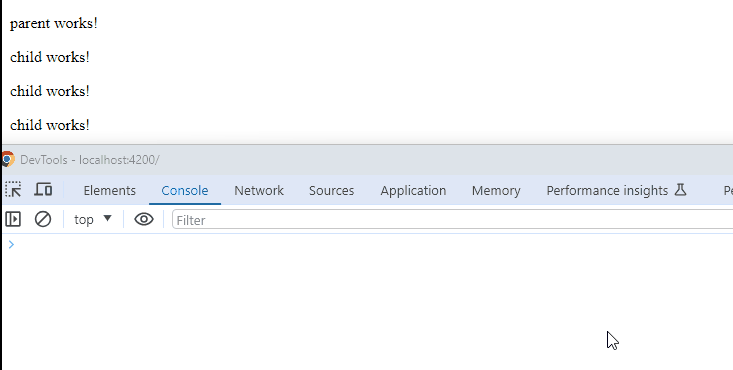
这个方案不仅仅可用于 query child,想用于 query parent 也是相同思路,只要把 querySelectorAll 换成 parentElement 或者 cloest 向上查找就行了。(注:Angular CDK Scrolling 里也使用了这个方案)
DOM query 方案要注意的事项
直接操作 DOM 通常是不顺风水的,容易掉坑。但如果你熟悉 Angular 底层机制的话,一切是可以 under control 的,不必担心。
我个人建议:
-
首选 Angular way -- viewChild, contentChild
-
次选 "use inject instead of query" 方案
-
真的摆不平,才出杀手锏 -- DOM query 方案
总结
本篇介绍了一些 Angular 常见的 query 局限,并提供了一些粗糙的解决方案,happy coding ??





